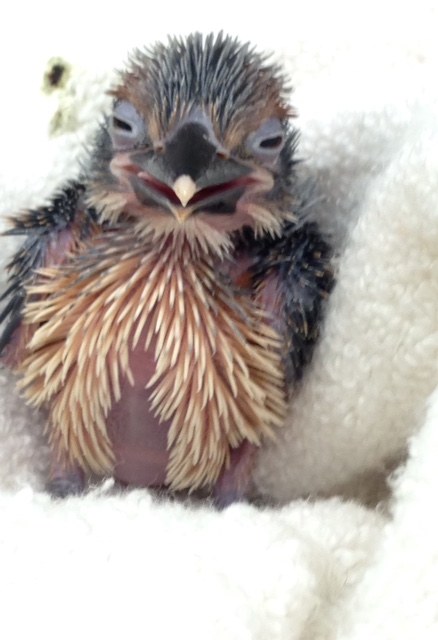
Zoo Welcomes Another Cute—But Gravely Endangered—Face
Albuquerque’s new Guam kingfisher chick bolsters the genetic pool of the species, which is extinct in the wild.
Aug. 1, 2018 - Add one more adorable animal to the recent baby boom at the ABQ BioPark. On June 9, the Zoo welcomed a female Guam kingfisher chick. The species is extinct in the wild and only exists in zoological facilities.
Eowyn—named after the famous character from Lord of the Rings—will be an important cog in the wheel for the preservation and, one day, rewilding of this species. That’s because conservationists hope to keep the genetic lines of this species strong so that they can be reintroduced to the island of Guam when the time is right.
The species was wiped out from its wild habitat when the brown tree snake from Australia was inadvertently introduced to Guam after World War II. This arboreal hunter greatly reduced populations of many avian inhabitants of the island. Scientists collected as many kingfishers as they could and started breeding programs in zoological facilities across the United States. The US Fish and Wildlife Service won’t release any kingfishers until they’re able to control the brown tree snake population. But, “they’re still—40 years later—trying to get rid of this snake,” said Diane Longenecker, senior bird keeper at the Zoo. “It’s a formidable opponent.”
"It’s always challenging, it’s always a fight, it’s always frustrating, it can be heartbreaking, but when you’re successful, it’s a great feeling and you know somewhere in your soul that they could really make it."
In the meantime, the ABQ BioPark is doing what it can to contribute to the species’ gene pool. “This new birth is significant because they don’t exist in the wild,” said Longenecker. “Especially a female—she’ll go on to lay eggs and produce a new generation.”
At the first sign of hatching, zookeepers collected the egg from the nest and allowed it to hatch without intervention. In captivity, Guam kingfishers often mistake their offspring for the small pinky mice that are part of their diet—chicks are featherless, pink and less than an inch long. This means zookeepers are picking up the slack on parental duties. Staff members care for the chick from 6 a.m.-7 p.m. daily. At birth, they fed her seven times per day and now it’s down to three meals.
Although Longenecker acknowledged that Eowyn is in the “teenager” stage of her development, she still loves helping to rear her. Kingfishers learn much through instinct, but some behaviors are learned so Longenecker is helping to wean the chick by mimicking behavior that parents would use in the wild. For instance, kingfishers would normally try to coax their chicks out of the nest by beginning to plop food right outside of a nest instead of inside the chick’s mouth, so that’s what Longenecker will do.
Longenecker enjoys her work with endangered species at the ABQ BioPark—among other species, the facility also has a breeding program for the Socorro dove, which is also extinct in the wild. “It’s always challenging, it’s always a fight, it’s always frustrating, it can be heartbreaking, but when you’re successful, it’s a great feeling and you know somewhere in your soul that they could really make it,” she said.
